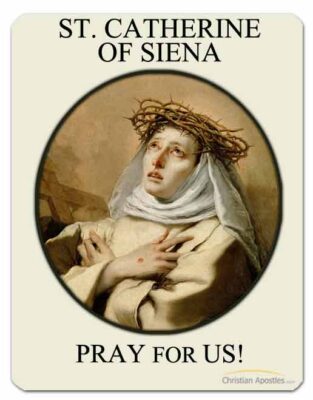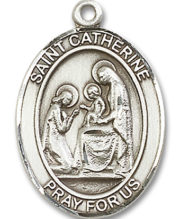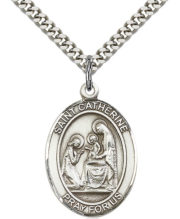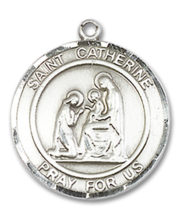Saints
St. Catherine of Sienna Medal – Patron Saint of Miscarriages
“The lips of the unwise will be telling foolish things, but the words of the wise shall be weighed in a balance.” (Ecclesiasticus, Ch. 21, v. 28.)
Short Biography of St. Catherine of Siena
St. Catherine of Siena was a 14th-century mystic, religious leader, and author who is known for her deep devotion to God, her spiritual writings, and her role in the politics of her time. She was born on March 25, 1347 in the city of Siena, Italy, the 25th of 25 children in her family. From a young age, Catherine displayed a deep religious devotion and a love for prayer.
As a teenager, Catherine began experiencing visions and mystical experiences, and she decided to dedicate her life to God by becoming a tertiary of the Dominican order, meaning she lived as a layperson but followed the rule of the order. Catherine devoted herself to a life of prayer and service to the poor and sick.
Catherine also began to write about her spiritual experiences, and her writings soon gained a wide audience. One of her most important works is “The Dialogue,” a book of mystical theology in which she describes her conversations with God and her understanding of the nature of divine love.
In 1376, Catherine journeyed to Avignon, France, where the papacy was based during the Western Schism (a time where there were multiple popes claiming to be the only legitimate one) , She hoped to convince Pope Gregory XI to return to Rome, which he eventually did. Her efforts helped to end the Schism and unite the Church under one Pope.
Catherine also became involved in the politics of her time, working to promote peace and reconcile rival city-states in Italy. Through her writings and personal diplomacy, she had a great influence on the political and spiritual leaders of her time.
Catherine died on April 29, 1380, at the age of 33. She was canonized by Pope Pius II in 1461, and she is one of the two patron saints of Italy. Her feast day is celebrated on April 29.
St. Catherine of Siena is remembered for her deep devotion to God and her role as a spiritual leader, but also for her contributions to the Church and society. Her book “The Dialogue” is considered to be one of the most important works of mystical theology and her writings on the nature of divine love continue to be studied and revered today. Her efforts to end the Western Schism and unite the Church under one Pope and her political efforts to promote peace and reconciliation in Italy, stand as testament to the deep impact that her spiritual vision had in the world.
Her spiritual writings and mystical experiences are still widely studied and admired, and her devotion to God and her willingness to serve others continue to inspire many people today. Many Catholics consider her one of the most important mystics in Church history, and her writings are considered important texts in the history of Christian spirituality.
Detailed Biography of St. Catherine of Siena
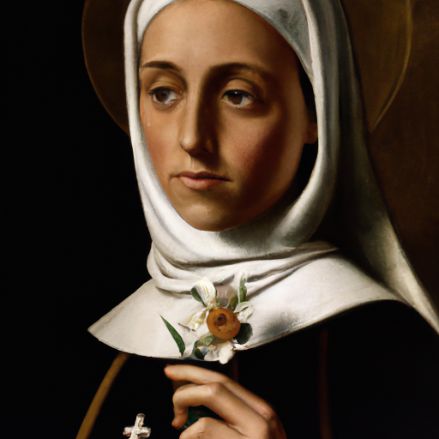 St. Catherine dedicated much effort to caring for both the body and mind and heart of those who suffered the pains of miscarriages or illness during their pregnancy. She prayed reverently for their recovery and the repose of the soul of the lost child. Still to this day, we can call upon the intercession of St. Catherine of Sienna, patron saint of those who have suffered a miscarriage, for those suffering these pains to this day. Learn more about the incredible life of St. Catherine of Sienna.
St. Catherine dedicated much effort to caring for both the body and mind and heart of those who suffered the pains of miscarriages or illness during their pregnancy. She prayed reverently for their recovery and the repose of the soul of the lost child. Still to this day, we can call upon the intercession of St. Catherine of Sienna, patron saint of those who have suffered a miscarriage, for those suffering these pains to this day. Learn more about the incredible life of St. Catherine of Sienna.
The Setting of St. Catherine’s Life
Catherine was born at Siena, Italy, in the year 1347, in an era of political turmoil and unrest. The country of her birth was bursting with internal strife. Every Italian city was a little independent state, with each faction making war against the other. It was a time of misery, famine, and bloodshed. It was also a bad time for the papacy, an affair in which Catherine was destined by God to play such an important role.
Pope Boniface VIII had been experiencing many difficulties with France and King Philip the Fair. His immediate successor Pope Benedict XI, a rather mild man, held the pontificate for about nine months. After his death there was a prolonged conclave of about eleven months, and through the influence of the French Court, the Archbishop of Bordeaux was elected Supreme Pontiff, and became known as Clement V. Against the invitations of the Cardinals he refused to go to Rome, which has been the traditional See of the Holy Father from the very beginning of Peter’s occupancy in that city.
Clement V chose to have his coronation at Lyons, and he established his residence at Avignon, a city which fell under the influence of the French Court, although not within French territory. There, at Avignon, the papacy remained for seventy years, and from there the Church was ruled during the period which historians have come to call the Babylonish Captivity. The Popes, who succeeded Clement V, appointed legates as rulers of the Papal States in Italy, and designated representatives to the various republics.
To Pope Gregory XI, who ruled from 1370 to 1378, belongs the credit for having terminated the so-called Avignon Captivity. The hostility of the Visconti of Milan and the Republic of Florence, as well as the efforts of many Papal cities to throw off the allegiance to the Pope, convinced Gregory that no one but the Supreme Pontiff could restore Papal power in the states of the Church. Yielding finally to the entreaties of Catherine of Siena and the Romans, who insisted that the residence of the Pope at Rome was necessary to prevent a schism, Gregory XI left Avignon in 1377 and returned to Rome, in spite of the opposition of the French Cardinals.
Excluding the Great Schism which follows upon the Avignon Captivity, and in which Catherine also became involved, this is an overview of the turbulent period in which Catherine was born and lived her life.
The Life of Saint Catherine
 She was the daughter of Giacomo Benincasa and his wife, Lapa, and the youngest of twenty-five children. Her parents were of ordinary means and her father was a dyer by profession. From a very early age Catherine showed signs of very great sanctity. She gave herself to prayer and fasting and made it very clear to her family and her friends that she was not interested in romance or marriage.
She was the daughter of Giacomo Benincasa and his wife, Lapa, and the youngest of twenty-five children. Her parents were of ordinary means and her father was a dyer by profession. From a very early age Catherine showed signs of very great sanctity. She gave herself to prayer and fasting and made it very clear to her family and her friends that she was not interested in romance or marriage.
Her confessor, it is related, knowing Catherine’s wishes to remain a virgin in the world, as well as her parents’ determined wish to find her a husband, suggested that she cut off her hair which she promptly did, thereby infuriating her family. The story is told that her father, thinking seriously about this impetuous action on her part ran into Catherine’s room one night as she was deep in prayer. He was amazed to see a dove hovering above her head. From that time on he did not bother his daughter, and she was allowed to follow her own pursuits and spiritual desires.
After great persistence on her part, the age of sixteen Catherine was allowed to become a Dominican tertiary. She wore the Dominican habit but was allowed to live with her family, and travel about, which she did a great deal until her death. She followed the Dominican rule very strictly and was untiring in her care of the poor her nursing of the sick. She fasted constantly and gave up the eating of meat and sustained herself on bread and raw vegetables. For long periods of time, it is related on good authority, she ate practically nothing and subsisted solely on the Blessed Eucharist which she received daily.
A Bride of Christ
Saint Catherine, like St. Teresa of Avila, had an unusual mystical union with God. She experienced ecstatic trances and became elevated from the ground, like the great Spanish mystic, usually after she had received Holy Communion. Her own confessor, Blessed Raymond of Capua and other witnesses verify this phenomenon. Catherine also spoke many times of the invisible ring placed on her finger by which she had been mystically wed to Christ.
She wore a hair shirt for a while but eventually replaced this with a very uncomfortable iron chain about her waist. Wearing the Dominican habit she continued an almost unbelievable round of spiritual activity and penance. Her contemporaries tell us that she went almost completely without sleep, and in later years she permitted herself only about a half-hour rest every two nights.
Like St. Rose of Lima of the seventeenth century who was to adopt Catherine for her model in life, St. Catherine had great compassion on the poor and the sickly. Although the young woman was almost a semi-invalid because of her extreme fasting and of these penances, she worked tirelessly in her care poor for the poor and the sick. In particular, she cared for and consoled women and couples who were experiencing illness in pregnancy or the pains of miscarriage.
As already stated, Catherine wanted to remain a virgin, and so she took the vow of virginity, but her parents and friends continued to press her about the subject of marriage and about finding her a suitor. She had a wonderful magnetic personality and charm that attracted everyone who met her. Although she had many women friends, the largest part of her friends were members of the male population, cleric and layman alike, who addressed her by the affectionate term of “mother”.
St. Catherine of Sienna – Doctor of the Church
 There were many people who did not completely understand Catherine and her life for them was something of a puzzle. Today, too, she remains something of a mystery to many people, who find it hard to reconcile canonized sanctity with the fact that she lived with her parents, twenty-four brothers and sisters, and later many of their children in the one house. It is difficult to visualize how she found the adequate privacy so necessary for prayer and meditation in the midst of all this family activity, or furthermore why she would want to remain in such surroundings.
There were many people who did not completely understand Catherine and her life for them was something of a puzzle. Today, too, she remains something of a mystery to many people, who find it hard to reconcile canonized sanctity with the fact that she lived with her parents, twenty-four brothers and sisters, and later many of their children in the one house. It is difficult to visualize how she found the adequate privacy so necessary for prayer and meditation in the midst of all this family activity, or furthermore why she would want to remain in such surroundings.
Secondly, her association with unmarried men at all hours of the day and night, might in our day cause a few raised eye brows, as indeed it did in her own day in some quarters. Her tremendous learning and sanctity, however, were so well-known, that there was actually no grave scandal, and although she was criticized for being so much with men, no woman was more capable of keeping them in their place than Catherine.
It is said that many a young nobleman, who had been living a sinful life, reformed after talking with Catherine, and at one time, three priests in her community were engaged in hearing confessions almost for the entire day of penitents whom Catherine had converted back to God. Artists, poets and writers used to visit Catherine and talk about their works. Her advice and suggestions encouraged them to accomplish even greater handiwork.
St. Catherine Benincasa was certainly an opinionated woman, rather extreme and dictatorial in her language, and yet a woman possessing no official position of authority. Without any qualms what so ever, she severely castigated people of the Church from the Pope on down to the lowest form of cleric, when she felt such reprimand was necessary. She was unlearned and could not write herself, but she had scores of secretaries to whom she dictated letters to the Popes at Avignon and the rulers of nations, letters of magnificent depth in which she minced no words. It was a marvel to some and a source of shock to others that she taught without being learned, and yet Catherine, herself claimed that her teaching and her words came from Divine inspiration.
By many of her contemporaries she was certainly regarded as meddlesome, but history has shown that she might well be called the unofficial ecclesiastical “ambassadress without portfolio” of her age. She was a letter writer “par excellence”, and the exact number of her writings, which were in the hundreds, and many of them written while she was in the state of trance, is not actually known. As a letter writer, however, she was not the so-called anonymous reformer who excoriates and then wishes to hide. She was courageous and frank, a woman who was intelligent and thoroughly informed about the events and the tides of her times.
It is recorded that her famous work, “Dialogue”, which has been classified as an outstanding treatise on religious mysticism, was dictated to several of her followers in a period of five days while she was in a state of ecstatic trance.
Adviser to the Popes
St. Catherine of Siena wrote to the Popes at Avignon, beseeching them to return to Rome, and while addressing them in terms of affection and devotion, she did not hesitate to use the greatest freedom and abandon in her speech. Constantly she wrote to Gregory “to play the man” and terminate the captivity at Avignon. When that timorous Pope showed his hesitancy about doing what Catherine so strongly urged, she personally went to see him at Avignon, and informed him that she had been appointed by God to plead that he return to Rome. Doubtless she repeated at that time what she had already written him: “Come, come, and resist no more the will of God that calls you. The hungry sheep await your coming to hold and possess the place of your predecessor, the Apostle Peter. For you, as the Vicar of Christ should rest in your own place.“
Catherine, indeed, was extreme in her language, but like the prophets of the Old Testament or the Apostle Paul, she was moved to violent expression when confronted with any great evil, for the zeal of the Lord’s house consumed her. Her political projects, however, with the exception of persuading Pope Gregory XI to return to Rome, were pretty much a failure, for she did not possess the worldly experience or political acumen displayed by the practical politicians of her time.
One would imagine that a woman so frank in her language, was not well-equipped for any diplomatic mission, but it is a known fact that she under took or was sent on a number of these ventures. Once she was sent as emissary from the city of Florence to the Pope, and another time she went to Queen Joanna of Naples in an endeavor to detach her from the cause of the anti-pope. She even wrote to the King of France urging him to form a crusade and end the dissensions in Christendom.
St. Catherine’s Zeal for the Church
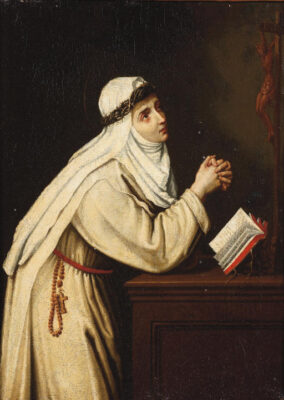 No doubt there are many today who would regard Catherine of Siena as an extremist, and possibly today in any diocese her own bishop might regard her as something of a problem. The fact remains, however, that she was a saint as her life and her accomplishments prove. She always inspired awe in those who knew her, and her zeal in trying to affect reformation in church and state is perhaps without equal in the ranks of women saints.
No doubt there are many today who would regard Catherine of Siena as an extremist, and possibly today in any diocese her own bishop might regard her as something of a problem. The fact remains, however, that she was a saint as her life and her accomplishments prove. She always inspired awe in those who knew her, and her zeal in trying to affect reformation in church and state is perhaps without equal in the ranks of women saints.
That zeal, however, was not a blind fervor, but one tempered with thoughtfulness, and when Urban VI succeeded Pope Gregory XI and faced many problems which Catherine tried to help him solve, this good sense became apparent. Pope Urban tried in haste to correct the many abuses which confronted him, and Catherine advised him to approach these matters more slowly and with greater equanimity. She wrote: “You must be patient, Holy Father. You cannot reform everybody all at once. Justice without mercy easily turns into cruelty.“
Like Our Divine Savior, Who spent thirty three years upon earth, Catherine of Siena, His mystical bride, died at the age of thirty-three in the year 1380. As she lay on her death-bed, paralyzed from her waist down, she said to those about her posing a question that must have been on the tongues of many, and answering it herself: “What is my nature? My nature is fire .”-truly a summary of her life!
The Lasting Impact of St. Catherine of Sienna
Joan of Arc came forth when France needed her most and she fought for God and country, but Catherine of Siena was really the progenitor of women in public life and politics. She was extreme but she lived in an extreme period when powerful action was necessary.
Today, the thinking Catholic woman can accommodate the spirit of Catherine of Siena to the topics and the troubles of this century. The women of today wield a far greater influence than their antecedents in Catherine’s time. They are rightfully accepted and respected in high government positions, as Senators, Congresswomen, Ambassadors, and in Cabinet posts.
Catherine of Siena, above all else, is living proof of the power of women and the power of the pen in counteracting public evils. There is an old magazine saying,-“Never underestimate the power of a woman!’ This power in counseling the doubtful, power and protecting public morality, can be exercised by the intelligent Catholics today just as fruit fully and capably as it was employed centuries ago so forcefully by St. Catherine of Siena.
Live out the holy example of St. Catherine in your own life
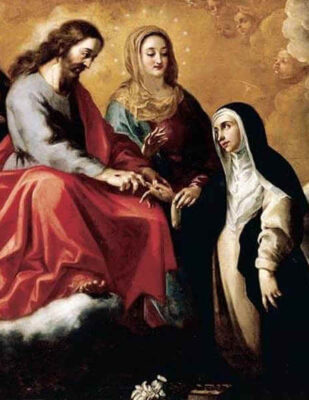 No Catholic woman of today can ever be an exact duplicate of St. Catherine of Siena. The extreme penances and near starvation that hastened her early demise, in an era when most people did not live to any advanced age, are not to be recommended for imitation, as she, herself, said many times to her followers.
No Catholic woman of today can ever be an exact duplicate of St. Catherine of Siena. The extreme penances and near starvation that hastened her early demise, in an era when most people did not live to any advanced age, are not to be recommended for imitation, as she, herself, said many times to her followers.
The woman of today, however, can imitate her tireless ways and fortitude in trying to eradicate the errors of the society in which we live, by counseling the doubtful and correcting those who err. This can be accomplished by good example, by registering a Catholic viewpoint when an issue demands it, and by the written word. The well-thought-out letter might never be published in a magazine with national circulation or even the local tabloid. Although the writer might feel it to be insignificant, the true fact of the matter will probably be that the letter will not go unnoticed, but will accomplish much good on the level of the local community or the Federal government.
The modern Catholic should remember that God has entrusted them with a portion of His goodness, His truth, and His beauty, and He does not want us to let that power become stagnant. One way of putting that circulation as so often done by St. Catherine of Sienna is by the oral word, and by the written power into word, and by positive, charitable and constructive suggestions, when their action will fulfill a good purpose.
Remember always the words of St. Paul, whose spirit must have guided the great Catherine of Siena, for they were kindred souls: “Be not overcome by evil, but overcome evil by good.” She must finally remember never to become discouraged in this perpetual program of social reform, and never to lose patience in her efforts, but call to mind the words addressed by St. Catherine of Siena to the Holy Father, himself: “You can’t reform everybody all at once. Justice without mercy easily turns into cruelty.“
PRAYERS TO ST. CATHERINE OF SIENA:
O glorious St. Catherine, wise and prudent virgin, thou who didst set the knowledge of Jesus Christ above all other knowledge, obtain for us the grace to remain inviolably attached to the Catholic Faith, and to seek in our studies and in our teaching only the extension of the Kingdom of Jesus Christ our Lord and of His Holy Church, both in ourselves and in the souls of others. Amen.
Prayer written by St. Catherine of Siena
Eternal God, eternal Trinity,
You have made the Blood of Christ so precious
through His sharing in Your Divine nature.
You are a mystery as deep as the sea;
the more I search, the more I find,
and the more I find the more I search for You.
But I can never be satisfied;
what I receive will ever leave me desiring more.
When You fill my soul I have an ever-greater hunger,
and I grow more famished for Your light.
I desire above all to see You,
the true light, as you really are. Amen.
Prayer written by St. Catherine of Siena
Most Holy Spirit,
source of unity in the Blessed
Trinity, through the prayers of
Saint Catherine, may the Church
always be a sign of unity in faith
and morals under the
leadership of the Holy Father,
the divinely chosen authority who
speaks in the name of Jesus
Christ. Who with the Father
and the Son lives and reigns
forever.
Amen.
Prayer for the intercession when putting on a St. Catherine of Sienna Medal
O Saint Catherine of Siena, God our Father enkindled the flame of holy love in your heart as you meditated on the Passion of Jesus His Son. Moved by His grace, you devoted your life to the poor and the sick, as well as to the peace and unity of the Church. Through your intercession, may we also come to know the love of Jesus, bring His compassion to all, and work for the unity of His Church. We ask this in Jesus’ Name and for His sake. God, You caused St. Catherine to shine with Divine love in the contemplation of the Lord’s Passion and in the service of Your Church. By her help, grant that Your people, associated in the mystery of Christ, may ever exult in the revelation of His glory. Amen.
Prayer to St. Catherine of Siena for Expecting Mothers
Humble virgin and Doctor of the Church, in thirty-three years you achieved great perfection and became the counselor of Popes. You know the temptations of mothers today as well as the dangers that await unborn infants. Intercede for me that I may avoid miscarriage and bring forth a healthy baby who will become a true child of God. Also pray for all mothers, that they may not resort to abortion but help bring a new life into the world. Amen.
A Prayer to St. Catherine of Siena
Almighty and everlasting God,
who chose St. Catherine of Siena to be a mirror of your love,
grant us, through her intercession, the grace to imitate her love for you
and for our neighbor.
Through Christ our Lord. Amen.
St. Catherine of Siena’s Prayer for Peace
O God of peace,
who raised up St. Catherine of Siena
to be a peacemaker in a troubled world,
grant us, through her intercession,
the grace to work for peace in our own time.
May we be channels of your healing grace
and bring the light of Christ to all those in need.
Through Christ our Lord. Amen.
A Novena Prayer to St. Catherine of Siena
O St. Catherine of Siena,
model of prayer and contemplation,
teach us to follow your example
and to be always united to our Lord Jesus Christ.
Through your intercession,
obtain for us the grace to live a life of holiness,
and to persevere in faith, hope, and charity,
until we enjoy the fullness of God’s presence in heaven.
Amen.
Popular St. Catherine of Siena Medal and St. Catherine of Siena Rosary
A St. Catherine of Sienna medal or a St. Catherine of Sienna rosary is a perfect gift to give to a young woman who has chosen St. Catherine as their confirmation name or to give to any person who is suffering illness, facing sexual temptations, is an expectant mother, or a nurse!
As the patron saint of expectant mothers, fire prevention, sexual temptations, nurses, and those who are sick, wearing a St. Catherine of Sienna medal daily is a perpetual prayer for Saint Catherine to intercede on behalf of the wearer. As saints are united closer to God, their prayers are more efficacious, and enriches your own prayer.
Additionally, a Saint Catherine of Sienna medal pendant is a reminder to emulate the example of the holy saint in your own life. What a beautiful testament of faith to share with the world, or to keep discretely tucked under your clothes. During the challenging moments of your day, reflect upon the holy life of St. Catherine and pray for their intercession and protection.
Our beautiful hand pressed St. Catherine of Sienna Medal pendant features an image of St. Catherine kneeling before the infant Jesus in the lap of the Blessed Mother Mary. This image is based on the vision St. Catherine had of the mystical marriage to Christ. Surrounding the image is the words “St. Catherine Pray for Us”
Medals and Pendants
Medals and Pendants
Patron Saints - C's
Medals and Pendants
St. Catherine of Siena: The Patron Saint of Italy and Firefighters
St. Catherine of Siena, born in 1347 in Siena, Italy, is a revered figure in the Catholic Church and is widely recognized as the patron saint of Italy and firefighters. St. Catherine was a mystic, visionary, and spiritual advisor who lived a life dedicated to the service of others and the promotion of peace and harmony.
St. Catherine’s writings and spiritual counsel earned her a reputation as one of the greatest spiritual leaders of her time, and she was highly regarded by popes and political leaders alike. She was particularly known for her work as a peacemaker, working tirelessly to end the conflict and division that plagued Italy in the 14th century.
In recognition of her contributions to the Church and her role as a peacemaker, St. Catherine was canonized as a saint by the Catholic Church and is now widely recognized as the patron saint of Italy and firefighters. She is also considered one of the patron saints of Europe and is revered as a model of wisdom, compassion, and selflessness.
St. Catherine’s feast day is celebrated on April 29th, and it is customary for Catholics to attend Mass in her honor and to pray for the continued growth of the Church’s ministry to those in need.
The legacy of St. Catherine of Siena continues to inspire Catholics around the world, who are drawn to her example of selfless service and her commitment to promoting peace and harmony in a world that often seems divided and chaotic. Through their own actions, they strive to embody the ideals of St. Catherine and to continue her mission of bringing hope, comfort, and healing to those in need.
Reflection on the feast day of St. Catherine of Siena
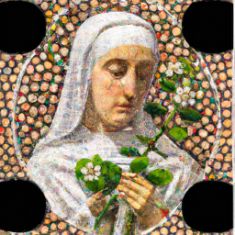 The feast day of St. Catherine of Siena is on April 29th.
The feast day of St. Catherine of Siena is on April 29th.
St. Catherine of Siena was an Italian mystic, activist, and theologian of the 14th century. She is remembered for her deep devotion to God, her writings, and her active role in the politics and religious life of her time. She is one of the patron saints of Italy, and the patron saint of Europe, and of fire prevention.
On the feast day of St. Catherine, we are called to reflect on her life and the example she set for us. We can learn from her deep devotion to God and her dedication to serving others. She had a strong sense of compassion and empathy, which led her to dedicate her life to the poor and the sick, and to take an active role in the political and religious life of her time.
St. Catherine’s writings, particularly her “”Dialogue of Divine Providence””, are considered masterpieces of Christian mysticism and spirituality. They offer guidance and inspiration for those seeking to deepen their spiritual lives and to draw closer to God. Her writings are also a testimony of her deep understanding of the faith and her own personal relationship with God.
St. Catherine was also known for her leadership and advocacy, particularly in the Church. She played an important role in the return of the papacy to Rome from Avignon and her letters and advice were sought by Popes, Kings, and other important figures of her time. She is a model for those who want to live a life of holiness and service to the Church and to the community.
In this homily, let us ask for the intercession of St. Catherine, that we may be inspired by her example to deepen our own devotion to God, to serve others, and to take an active role in the Church and in the world around us. May her writings and her example guide us in our own spiritual journey and may her leadership and advocacy be an inspiration for us to strive for justice and peace.
Discover biographies, prayers, and reflections for more than 400 Catholic Saints“
Saints Similar to St. Catherine of Siena
You may also be interested in reading the Biography of St. Catherine Laboure and the Biography of St. Catherine of Bologna and the Biography of St. Catherine of Alexandria. Next up: Biography of St. Catherine of Sweden
Also check out our handmade St. Catherine of Siena Medal and St. Catherine of Siena Rosary and St. Catherine of Siena Rosary Bracelet.


